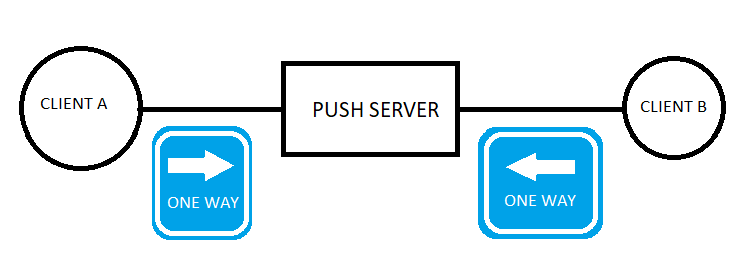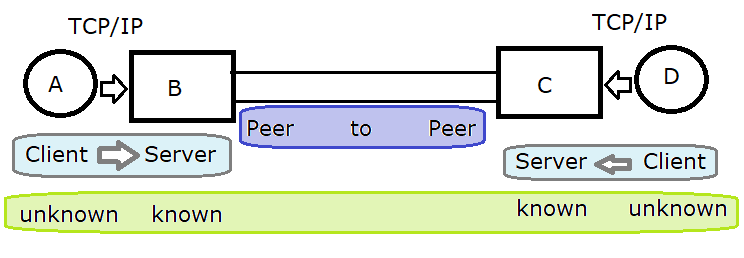A server cannot initiate the connection to the client. So the Client Server protocols are typically request - respond.
You cannot get to the unknown, as you do not know where it is. I could call this Doug Rice's "Unknown" theorem.
If I know your phone number and you know mine, we can dial each other as we choose.
We have to exchange phone numbers and remember them.
If you come from the unknown to the known, maybe you can remember how to get back. How long can you remember how to get home?
How long does the network remember?

Client Server Peer to Peer Server Client

You cannot get to the unknown
If you come from the unknown to the known, maybe you can remember how to get back. How long can you remember how to get home?
Write down lists of types of connections and
| connection | time to establish | how long it persists | time to tear down |
| phone number to Phone in hall | order, reserve equipment, | years | years |
| local loop | time to install cables and green boxes | years | years |
| C7 call | Less than a second | as long as required | First party clear |
| serve web page | Request / respond | static | cached |
| serve web page images | time to download file | static | cached |
| people | introduction | varied | long time |
This lists some examples.
Telephone calls -
Dial a known telephone numbers. The mapping from the Telephone number to the telephone terminal probably goes through many wires and connections.
The PSTN is a distributed database, with the telephone mapping stored in the exchanges and billing systems. The STD codes route to the remote exchange and then to the remote concentrators. There is a mapping that maps phone number to to a wire. The wire goes to the green cabinets in the street, and eventually to a house.
The exact route in not documented. The green boxes may be documented and there is documentation of the cabble run. However, keeping track of the pair used in the cable in a central database is difficult. It is too difficult to document precisely.
A fault will happen and an engineer needs to find a free pair.
The linesmen uses a tone generator on the line, and finds the pair in the hole in the road using a tone generator. They ask the telephone exchange to apply a test signal which is also found.
The exchange data maps telephone number to terminal number using a propriety name.
One maps to a device id, which is a object that stores its type
I think that if you dial a mobile number, the PSTN knows how to route to the mobile network and to a known database that stores the last known cell.
The mobile phone has to periocially connect to the nearest cell.
A rule of thumb of routing is this. I have got to where I am, look around for a "signpost" that tells me how to get to the next node.
The server does not know where the Web browswer is until the client connects.
As the HTTP is set up, the source port is mapped by DHCP and NAT and the URL and DNS entry and "remembered" by the nodes it routes through.
http://ccgi.dougrice.plus.com/cgi-bin/wiki.pl?ADSL_Home_Hub_NAT_Sessions records some work on this.
When a telephone call is made using C7, the circuit was selected based on next free circuit at the start of the call. As far as I know, this remained for the duration of the call.
The IAM had opc,dpc,cic,sls. The pointcodes are "known", the cic maps onto a "known" E1 and TS, The SLS is used to pick the same signalling link. In C7 the wiring is "known" as it is decided when the tranmission system is installed.
User agent - A user agent is a logical network endpoint that sends or receives SIP messages and manages SIP sessions. User agents have client and server components.
If you run a VoIp Phone on your laptop, it's IP address could be allocated uing DHCP in the 192.168.1.xxx subnet. This could go via a NAT translation and you could start up multiple terminals on the same IP address.
This IP addess is "unknown", until the software registers terminal to telephone. With the mapping in place, the call to the telephone number can resolve down to the ip address and port. This is now "known" for the duration this exists. It may time out and become "unknown".
When I ring a mobile number, it routes to a known operator and the operator must "know" the mapping of phone number to SIM card, and hence device. The mobile moves around from cell to cell. I do not know quite how this is managed. You often get told that the number cannot be reached if the mobile has disconnected by the battery going flat.
Normally a phone call is VOICE so there is a TX and an RX.
For Textphones the user can TYPE and READ.
So now we have a many more possiblilities.
SPEAK and HEAR TYPE and READ TYPE and HEAR SPEAK and READ
so TX could be a combination of SPEAK, TYPE and RX could be a combination of HEAR , READ
Mathmatically these are vectors.
We could write down truth tables.
There are many ways for carrying the SPEAK, HEAR, TYPE, READ signals.